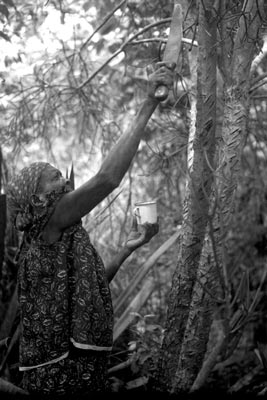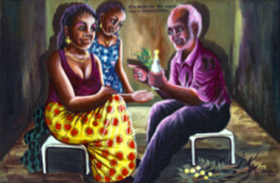
Sicknesses that “just happen” are contrasted in the storyline to those where “something else is going on.” These are plain English formulations of a very basic dichotomy that is frequently drawn in African medical thinking. The goal of this section is to make the visitor aware of the dichotomy and to show medicine as a response to the first, most straight-forward, type of sickness, that is what it appears to be and responds readily to therapy. Many practical cures are known by laypeople and healers for such sicknesses. Modern pharmacies and clinics are widely used for basic health needs.
African healing includes the preparation and transformation of plants and other raw materials used directly or combined into compounds for use by common people, technicians and consecrated experts. In addition to the power of these transformed materials, healing includes ritual actions by healers and clinical care by biomedical practitioners or actions within the context of relations between therapist and patient, family and community.

This exhibition section opens with the subsection African Traditional Medicine Today. It includes photographs of several Central African healers collecting plants directly from trees and shrubs, in the wild. One of these, Kongo healer Nzoamambu Oscar, is also shown alongside a scheme of all the domesticated plants he keeps in his village compound for medicinal, food, and ceremonial purposes. In a related photograph he is applying such plants, along with oil and a hot iron, to a patient with a back spasm.

A second subsection is entitled African Medicine in the Marketplace, that shows glimpses of the vast trans-national, trans-regional, indeed, global market, illustrated by Luba healer Tambwe Antoine at a Kinshasa urban market purchasing materia medica from Hausa merchants from the West African Sahel. A Johannesburg Muti (medicine) shop is depicted in a second photo. African traditional medicine has become big business in most rural and urban settings.

The subsection Precolonial African Medicine features a 1900 era doctor's kit from Eastern Congo with contents shown and identified--plant substances, duiker antelope medicine horns, a small medicine pot, and medicine packets--as well as the healer's performance paraphernalia--skirt and double gongs. A dance skirt and a double gong indicate the central role of rhythm and dance alongside herbal medicine in the overall performative character of this medicine, and the approach to health awareness and social prominence. Other items displayed here include a medicine horn, a finely carved wooden box which features two carved duiker horns, which are used to hold medicines suggesting this box’s medicinal contents, two carved enema funnels, teeth-cleaning twigs. A map showing the widespread geographic distribution of selected words of healer roles like nganga and the basic medicinal materials ti and kaya , with associated historical dates, demonstrate the deep historical roots of these traditions.

Pharmaceutical Developments of African Medicines presents the emergence of research institutes and commercial development around African medicine. A Kivu-based research center's herbarium shows large-scale production of medicinal plants, and Bukavu-based pharmacist Byamungu in his lab offers 23 manufactured medicines in regional pharmacies. A sampling of local or regional pharmaceutical products and globally-derived pharmaceuticals demonstrate the range and richness of pharmaceutically-developed medicines available to African clientele.

The Power of Healing in Ritual and Clinic presents a set of photos and a series of paintings depicting healers’ and biomedical clinics in Central and East Africa: A healing service of an Independent African Church, a nurse touching/holding a sick child; two paintings by Shula, Chez le guerisseur (At the healer, depicting massage), A la recherche de l’enfant chez le tradipracticien (The quest for a child-fertility--at the traditional practitioner), and a painting of the Muhimbili Teaching Hospital surgery theater in Dar es Salaam. For many clients, the source and tradition of a medical product or treatment is less important than whether it works, and meets their immediate needs.

Change and Pluralism is a final subsection that makes the point of the parallel and alternate use of medicines. Modern pharmaceutical drugs are available everywhere in Africa, sometimes replacing pre-existing treatments, as evidenced in the medicine figure that was exchanged for quinine malaria treatment early in the 20th century. Also shown is a painting depicting Muhimbili Hospital in Dar es Salaam as a full service mega-hospital, and a Kinshasa clinic of healer Lobiro whose billboard advertises his “international qualifications.”
After viewing this section Western visitors will be confident that African approaches to medicine and healing are quite similar their own medicine. African treatments will seem familiar, as is the extensive knowledge of plants for treatments of many kinds of common ailments, the practice of massage, and bone setting. The objects displayed and depicted in photographs suggest practical treatments, some resembling Western medicine of an earlier era. The inclusion of images of biomedical clinics and hospitals will demonstrate the availability of modern medicine. This exhibition section provides a familiar foundation for the more complex aspects of African sickness and medicine that follow.